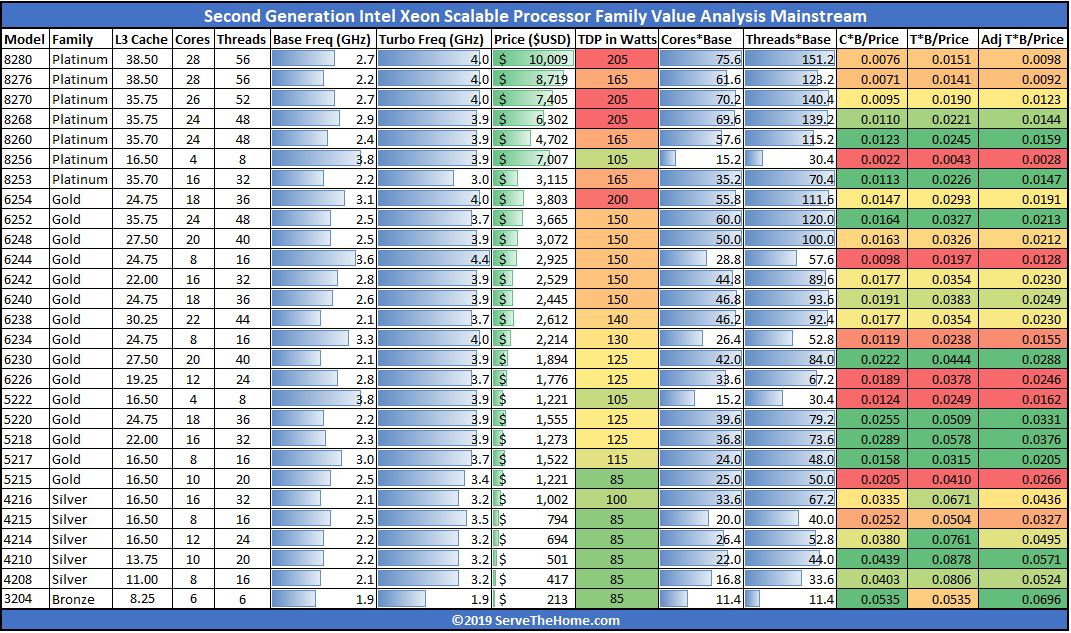Intel Xeon Platinum 8268 Market Positioning
Thes chips are not released in a vacuum instead, they have competition on both the Intel and AMD sides. When you purchase a server and select a CPU, it is important to see the value of a platform versus its competitors.
Intel Xeon Platinum 8268 v. Intel Alternatives
Combining 24 cores with higher clock speeds and giving the part a 205W TDP yields a surprising result. One gets the third best value in the Intel Xeon Platinum range when looking at the number of cores one gets and the clock speeds. Here is a chart from our Second Generation Intel Xeon Scalable SKU List and Value Analysis piece.

One point we would have liked to have seen is a 4.0GHz turbo frequency aligning the Intel Xeon Platinum 8268 to the same maximum as the 26 and 28 core Platinum parts. Since these chips are designed for four and eight socket systems, it is unlikely that they will see such low utilization that a single thread per chip is running where that 100MHz will matter. This is more of a marketing 100MHz and something we can see with synthetics rather than a real-world application 2.5% difference.
Pricing wise, Intel Xeon Platinum 8268 is one of the few SKUs that did not improve dramatically on a price for performance basis like we saw with the Intel Xeon Silver 4210 as an example. The new chip has pricing set at $412 over the Platinum 8168 and was one of the few SKUs where pricing went up. In a segment of the market where Intel will be at a very weak competitive position one quarter after launch, we found this list price movement to be strange.
Intel Xeon Platinum 8280 v. AMD EPYC Alternatives
At the time of this writing, the current generation of AMD product is the AMD EPYC 7001 series. If you are looking at the Intel Xeon Platinum for quad or eight-socket servers, or with Intel Optane DCPMM, then AMD EPYC is not in direct competition at the time of this writing. Of note with the Intel Xeon Platinum 8268 is that there are no M and L SKUs so usage with Intel Optane DCPMM will be limited with a 1TB maximum memory footprint.
The 2017 era “Naples” AMD EPYC generation EPYC 7601 is strong competition to the Intel Xeon Platinum 8268. They trade places on benchmarks and it is a testament to the Intel design team that they can do with 24 cores what AMD is doing with 32. Another benefit is that the Intel Xeon Platinum 8268 is a single NUMA node per socket design which is important for some workloads.
This is about to change. 96 cores/ 192 threads will be in the upper end of the AMD EPYC “Rome” generation dual-socket design. AMD is about to flat out have more cores, by more than 2x. Intel will point to its Platinum 9200 series instead of this Intel Xeon Platinum 8268, but we showed why that is not valid in our Why the Intel Xeon Platinum 9200 Series Lacks Mainstream Support piece.
This quarter, AMD will have:
- More than twice the cores
- Significantly more memory bandwidth
- More PCIe lanes
- PCIe Gen4 that will double bandwidth per lane
- Top-end 64 core/ 128 thread (per socket) list pricing significantly lower than the Intel Xeon Platinum 8268
- More memory capacity than the non-M and L parts
We covered the PCIe aspect in AMD EPYC Rome 2P Will Have 128-160 PCIe Gen4 Lanes.
When AMD is in the market with 64 core parts that cost less than the Intel Xeon Platinum 8268 we are going to be discussing whether one should buy a single AMD EPYC 7002 CPU or two of these Intel Xeon Platinum 8268 parts.
Final Words
With the Intel Xeon Platinum 8268 one gets 500MHz more on the base clock than the Intel Xeon Platinum 8260. Perhaps that is the best way to describe this chip. It offers excellent performance at a relatively low price point.
Versus the previous generation it offers:
- Higher clock and DDR4 memory clock speeds
- Security mitigations
- Limited Intel Optane DCPMM support (due to memory capacity limits)
- Intel VNNI for AI inferencing
Those are certainly enough to persuade new design wins to use the Intel Xeon Platinum 8268 over the Platinum 8168 even with a $412 increase in price.
As we are now about 1/6th into Q3 2019, the AMD EPYC “Rome” is coming. When it arrives, this is a part that we expect will need to see discounts of 60% or more to be viable in single and dual socket configurations and may even need discounting in 4-socket to stay relevant.




We’re talking $750 per core more to go 8280. Your paying more for those incremental cores than 12 core Xeon Silver. How did we get to this?
The problem AMD is going to have, and probably already has, is software ‘per core’ licensing. It’s not enough to have a bunch more cores, they have to be faster per core. If not you’ll get cool hardware that will absolutely kill you on software costs.
We will have a big discussion of that in our Rome launch.